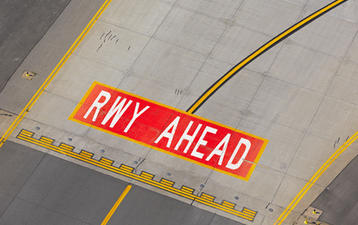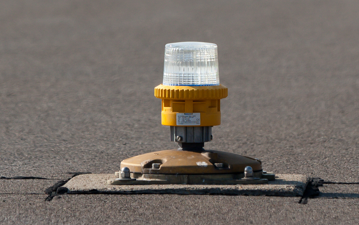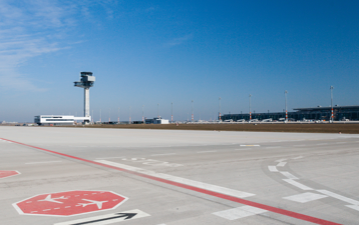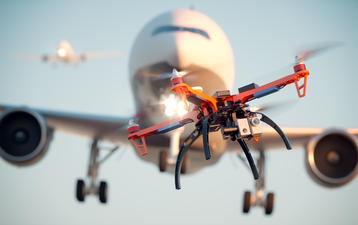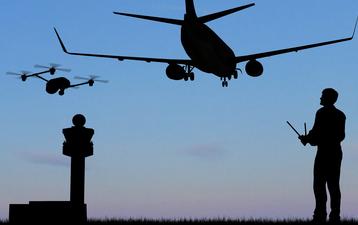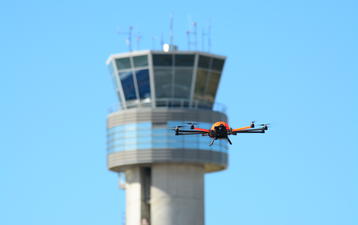Drone Incident Management at Aerodromes
Unmanned aircraft systems (UAS), commonly referred to as "drones", are more and more present these days. While being used responsibly, they can be a benefit to society (e.g. during rescue missions), create great video recordings (e.g. TV/film industry) or just be used for hobby-purposes.
However, unauthorised drone operations can become a significant safety hazard when being too close to aerodromes. Besides the evident safety hazard, if a drone is spotted near or at an aerodrome, flight operations are typically suspended or severely interrupted. This results in flight cancellations, major delays and therefore costs to aerodrome operators and airlines. For example, according to EUROCONTROL, a cancelled flight comes at a system-wide average cancellation cost of 18.570 €, while delayed flights can quickly cost more than 100 € per minute.
Being prepared is crucial to mitigate the associated risks as well as to minimise the economic impact. Part of this preparation is the establishment and implementation of a dedicated drone incident management process (e.g. in form of a Standard Operating Procedure) on how to manage drone incidents at the aerodrome. A solid process will save valuable time if operations are suddenly threatened by an unauthorised drone and decisions need to be taken to safely address the incident. Overall, this is somewhat similar to how aerodrome operators already cater for other “conventional” emergency situations. Participants will learn how a process should be structured and which subphases it contains.
This course will make the participants familiar with the key steps which are recommended to be implemented by aerodrome operators and involved stakeholders to cope with potential drone incidents at their aerodromes. Considering best practices, such as EASA and IATA guidelines and recommendations, participants will learn how to distinguish between actions that should be taken before, during and after a drone incident. This will ensure that both, proactive as well as reactive measures are implemented at the right stage and level. For instance, during a drone incident, actions should be taken and categorized according to defined phases (e.g. verification, decision, response, restoration phase). The elements of these phases depend on the complexity of the aerodrome. Furthermore, specific reaction teams or task forces could be established to channel the flow of information in case of a drone incident.
After the course, participants will have a better understanding of what drone incident management at their aerodromes means and which essential measures they or their entity can implement. Moreover, it will enable them to incorporate and align the drone incident management with the existing safety management system (SMS) as well as emergency response plans (ERP).
Course Details
Location:In-houseLanguage:German / English
Duration:2 days
Provider:airsight GmbH
Course Content
Motivation
- Recent cases of drone incidents and their impact
- Business continuity
- Compliance
UAS basics
- Terms and definitions
- Civil drone technology basics
Overview legal framework
- EASA UAS Regulation (EU) 2019/945 and (EU) 2019/947
- EASA operation categories: open, specific, certified
- Protection of ADR surroundings (ADR safeguarding) as required in EASA Basic Regulation (EU) 2018/1139 and (EU) 139/2014
Drone incident management at aerodromes – Phased approach
- EASA and IATA drone incident managment processes
- Roles and responsibilities
- Coordination with ATC and other stakeholders
- Application of risk assessment methodologies to a drone hazard
- Implementation of a dedicated drone incident procedure
- Application of checklists and tools that support drone incident management
- Short introduction to drone detection technology
- Documentation, records and reporting
- Continuous improvement
Trainer
Moritz Kaschel, M.Sc.
Moritz holds a Master’s Degree in Aeronautical Engineering and is further specialised in Airport Management Systems, Auditing and Aerodrome Planning. As a member of airsight’s consulting team, these combined competencies enable him to assist Aerodromes within their certification process and related fields (e.g. compliance checks and inspections, manuals and procedures, ground handling processes).
At airsight, he conducted several projects for airports such as Dublin, Milan, Luxembourg and others. He also conducted inspections of their airside infrastructure (incl. signs, lights, marking), including the assessment of the pavement conditions - using drones (as holding a commercial UAV operator license and radiotelephone operator´s certificate).
More recently, Moritz assisted Luxembourg Airport to obtain a new certificate in accordance to the new EASA requirements – a task of several months requiring a good knowledge of the applicable regulations as well as project management skills. Additionally, he was involved in the development of a corrective action plan for a major Middle Eastern airport and conducted airside infrastructure inspections in western Africa.
With his broad ranging experience regarding Airport Management Systems and Compliance, he is an instructor for multiple airsight courses.
Veronica Schömer, Pilot B787, M. Eng.
Veronica is a highly knowledgeable and experienced aviation expert with a passion for flight safety. She took her first steps into aviation more than 20 years ago in a glider club. As first officer on Boeing 737 and senior first officer on Boeing 747 and 787 Veronica gained more than 17 years of experience in commercial aviation with 7000 flight hours. She holds a bachelor’s degree in industrial engineering and a master’s degree in mechanical engineering.
Specialising in European aviation regulations, and with her thesis on Confidential Safety Reporting as a starting point, Veronica strives for the adaption of safety concepts known from commercial aviation to the rapidly evolving and diverse drone industry.
As a professional trainer, she has trained students of RWTH Aachen University in its flight simulator and developed training concepts to introduce new software to pilots.
With the JARUS Industry Stakeholder Board Veronica supports the successful integration of manned and unmanned aviation.
Target Group
- Aerodrome safety and operations managers
- Aerodrome security managers
- Aerodrome duty officers
- Aerodrome security and safety personnel
- Civil Aviation Authorities staff
- Air Traffic Control staff
- Governmental organisations and agencies (e.g. police, rescue and firefighting)
Organisational Details
airsight offers this training course on request, worldwide. At the end of the course, all participants will receive an airsight certificate based on EASA training regulations, which is highly recognized throughout the aviation industry.
About airsight Training
airsight Training course quality
airsight operates an ISO 9001 certified Quality Management System and pursues the objective to provide high quality services that fully meet the clients’ needs.
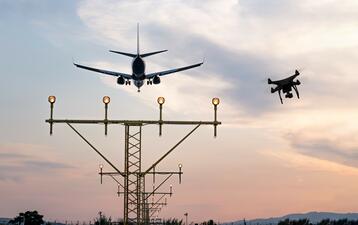
 Training 5 or more people? Ask for an In-house course at your premises or online!
Training 5 or more people? Ask for an In-house course at your premises or online!
